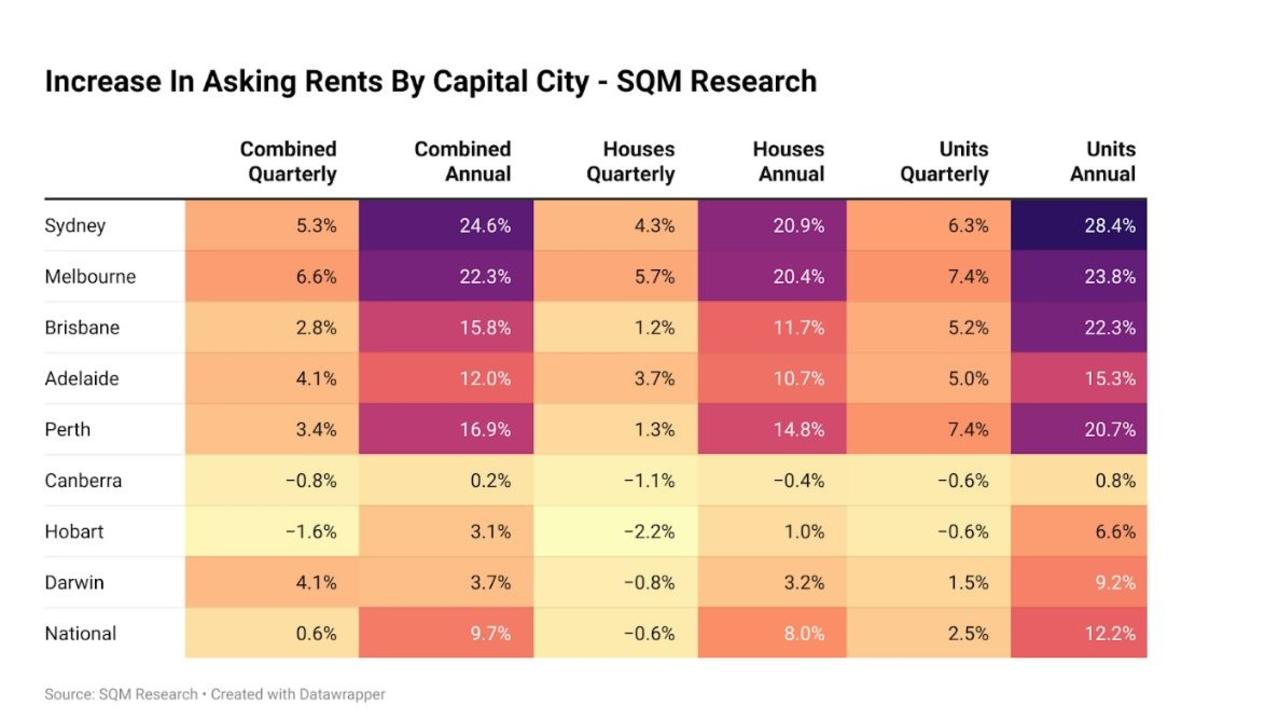‘Challenging’: Rental crisis all but over in parts of Australia as others suffer brutal conditions
While rents might actually be falling in some parts of the country, there’s a grim sign the crisis is just getting started in others.
ANALYSIS
Shortly after the pandemic arrived on Australia’s shores back at the start of 2020, the way that we chose to live and work was transformed.
Hundreds of thousands sought a ‘tree change’, ‘sea-change’ or some other form of move out of the city and into the regions, while at the same time, working from home swiftly evolved to become a way of life for millions of Aussie workers.
As a result of this additional demand from internal migration, new households and a long list of other factors, by the end of 2020, the rental crisis had already begun in many desirable regional areas.
Over time, the challenging conditions spread to encompass almost all rental markets in the country to one degree or another.
While there are signs that the level of rental increases has peaked at a national level, actual outcomes experienced vary widely depending on the locale in question and whether you’re talking about a house or some form of unit.
Much like the early days of the rental crisis in late 2020 and early 2021, there are regions of the country which are facing much tighter rental markets and greater rent increases than others.
In the beginning it was regional areas which saw the largest run ups in rents, but now that is reversing, as the rental crisis begins to fade in many regional areas and continues to remain acute in the capital cities.

The good news
As the outflow of Australians from the cities and into the regions begins to fade or even reverse entirely in the case of some locales, the demands placed on regional rental markets in aggregate have been reduced significantly.
This was noted by SQM Research’s Managing Director Louis Christopher in the firm’s latest National Rental Vacancy Report.
“For regions outside our capital cities, I believe there has been a population exodus back to our larger cities, driven by a return to office requirement set by many office employers. We are now recording rental falls or at least a stalling in rent increases for most out of city regions around Australia,” he said.
Even some of what were the nation’s hottest regions, such as the NSW North Coast and Queensland’s Sunshine Coast, have seen vacancy rates begin to normalise and overall rental price growth to slow significantly.
Considering the role domestic migration played in driving the outsized increases in regional rental markets and the possibility of this migration reversing, better days may lay ahead for renters in many regional areas.
But better days do not mean the challenge of far higher than pre-Covid rents does not remain. It could take years for wages to catch up with where they were relative to rents in the regions back before the pandemic turned things on their head.
Before we get to the challenging conditions in the most populous capital cities, in a more positive development, rents in Canberra and Hobart are falling on a quarterly basis, with overall asking rents down 0.8 per cent in Canberra and 1.6 per cent in Hobart.
The bad news
Despite rising rental vacancy rates in seven out of eight of the nation’s capital cities, for the majority of renters in the capitals, the rental crisis remains acute.
Continued strong demand for units and apartments has seen asking rents rise by 5.8 per cent over the past quarter and 24.5 per cent over the past year. By contrast, asking rents for houses have risen by 2.8 per cent over the last quarter and 16.9 per cent over the past year.
But not all of the five larger capital cities are experiencing the challenge of the rental crisis equally, even within an individual city.

For example, in Perth, asking house rents have risen by 1.3 per cent over the past quarter, which is below the headline rate of inflation. Meanwhile, growth in the rate of asking rents for units has risen by 7.4 per cent over that period and is showing little sign of slowing.
Of the five large capitals, the two seeing the largest increases in quarterly and annual asking rents overall are Melbourne and Sydney.
Considering that Australia has added more than 250,000 temporary visa holders in categories likely to require some form of housing over the last three months of available data, this is perhaps unsurprising.
According to the latest figures from the ABS, Victoria and NSW are the destinations for almost two-thirds of new arrivals as they put down their first roots in Australia.
The outlook
For the nation’s regional areas, it is generally a more positive picture.
Vacancy rates are slowly normalising and rental increases have in many markets been replaced by rent decreases.
To what degree this trend will continue will depend a great deal on what demand in these locales looks like as internal migration patterns find a new equilibrium.
In the capital cities it’s generally a far more challenging picture.
There is arguably a trend toward a more historic balance between supply and demand, and the normal levels of rental price growth that comes along with it, but it’s still generally early days.
To end on a more positive note, despite a surge in the number of temporary visa holders in categories likely to require housing in recent months, capital city vacancy rates have continued to rise, albeit slowly.
Australia remains far from the beginning of the end of the rental crisis, but we have passed the peak at a national aggregate level, and there is hope on a longer-term time horizon.
Tarric Brooker is a freelance journalist and social commentator | @AvidCommentator






